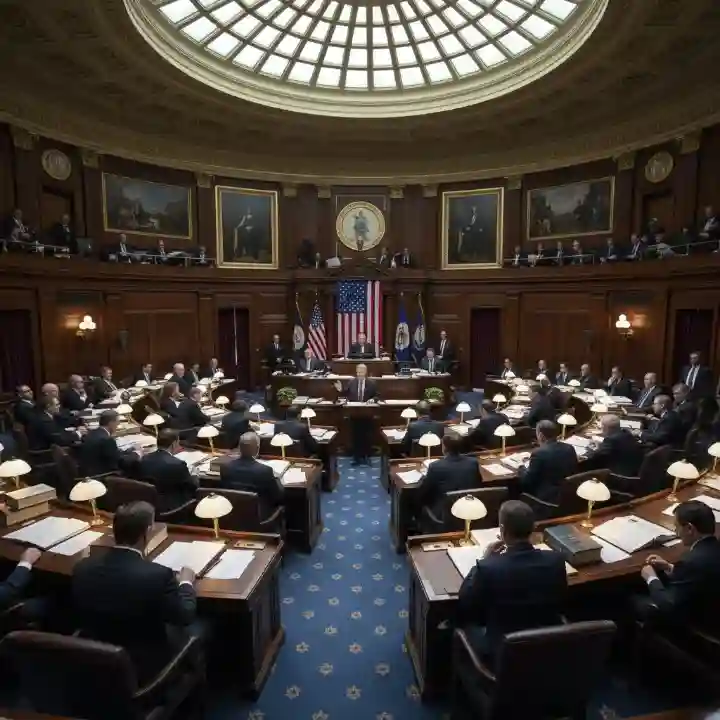Introduction
Imagine the frustration of federal employees missing paychecks for over a month, food assistance programs paused, and airline delays piling up all due to a government shutdown that became the longest in U.S. history. On November 10, 2025, the Senate broke this impasse by passing a crucial funding bill, signaling hope for reopening and relief. The “US government shutdown Senate passes funding bill 2025” marks a major turning point with wide-reaching implications for businesses, workers, and the overall economy.
This article unpacks the key details of this landmark legislative move, explaining why it matters and what’s next from clear, practical perspectives. Readers will gain insight into how government operations, markets, and everyday Americans are poised to respond and recover.
Why the Senate’s Funding Bill Passage Is Critical
The bill passed with a 60-40 vote, a bipartisan mix where nearly all Republicans joined eight Democrats who diverged from their party line. It authorizes government funding through January 30, 2026, covering agencies affected by the shutdown since October 1, and reinstates pay for hundreds of thousands of federal workers.
This decisive Senate action ended a 41-day shutdown that caused immense disruption, including delays in food aid for vulnerable populations and interruptions in essential services. The funding plan also includes three full-year appropriations bills for departments such as Agriculture, Veterans Affairs, and the Food and Drug Administration.
While Senate Republicans and Democrats agreed to reopen the government, controversy remains. The bill does not extend critical healthcare subsidies under the Affordable Care Act due to Republican resistance, leaving millions facing potentially higher premiums in 2026.
Experience and Real-World Impact of the Shutdown
A federal worker in Washington shared how the shutdown’s pay freeze caused serious financial strain: “I had to delay rent and other bills. This funding vote gives us hope, but the stress of uncertainty was tough.”
Businesses experienced ripple effects through reduced government contracts, increased airfare cancellations, and delayed permits. For instance, airlines reported hundreds of canceled flights as Transportation Security Administration staffing dropped.
Food banks and assistance programs saw heightened demand, with some rationing supplies amid stretched resources. The Senate’s agreement to fund SNAP benefits through September 2026 offers critical stability to vulnerable communities.
These ground-level stories spotlight why swift government funding restoration is vital to stabilizing both lives and the economy.
Breaking Down the Funding Bill: Simple Terms for Complex Politics
Here’s what the legislation does in straightforward terms:
-
Government Funding Extended: Funds federal agencies and programs through January 30, with some agencies receiving year-long appropriations.
-
Federal Staff Paid: Restores pay for furloughed employees, including back pay, and halts layoffs through the funding period.
-
Food Assistance Secured: Includes funding for programs like SNAP to operate without interruption.
-
Healthcare Subsidy Delay: Leaves the decision on Affordable Care Act subsidy extensions to future Congressional votes, complicating coverage prospects for 20+ million Americans.
-
Political Compromise: Reflects a tenuous agreement with bipartisan elements success in the House vote and presidential signature remain crucial before full reopening.
Understanding these components helps contextualize ongoing political negotiations and public impact.
Recommendations for Businesses and Citizens
In light of the Senate funding bill progress, here are practical suggestions:
-
Stay Updated: Monitor House proceedings for the final vote and presidential action.
-
Plan for Transition: Businesses relying on government contracts or impacted sectors should anticipate a ramp-up phase post-shutdown.
-
Review Financial Buffers: Federal employees and recipients of social services should assess savings and expenses during delayed payments.
-
Advocate Smartly: Constituents should engage legislators on pending healthcare subsidy debates.
-
Prepare for Market Volatility: Investors may see fluctuations amid policy uncertainty diversifying risk remains a sound approach.
Clear awareness and preparation help all stakeholders navigate this complex period effectively.
Common Pitfalls and How to Avoid Them
-
Assuming Immediate Normalcy: Full government reopening depends on House approval; some delays may persist.
-
Overlooking Healthcare Risks: Failing to track ACA subsidy status could lead to surprise expenses.
-
Underestimating Economic Ripple Effects: Small businesses and contractors may face gradual recovery, not instant rebound.
-
Ignoring Legislative Nuances: Public messaging and politics can evolve, making ongoing engagement important.
Avoid these mistakes to maintain resilience during the reopening phase.
Conclusion
The “US government shutdown Senate passes funding bill 2025” event serves as a crucial milestone to restore government functions, support federal workers, and mitigate economic disruption. While it does not solve every challenge such as healthcare subsidies it lays a foundation to rebuild trust and operations.
For business and finance professionals, understanding the bill’s contours aids in strategic planning and risk management. The coming weeks remain pivotal in confirming this bipartisan deal and charting a path forward.
Stay connected with news updates, consult experts, and prepare strategically to navigate this transition confidently.
Share your perspective on the government funding resolution in the comments. Considering professional advice can sharpen your approach in these uncertain times.
